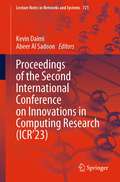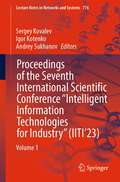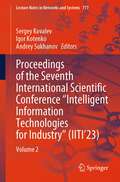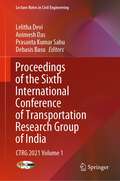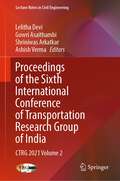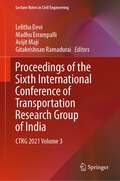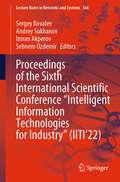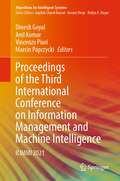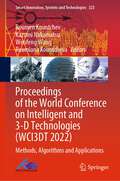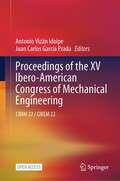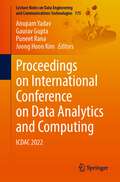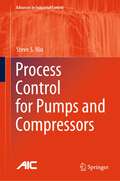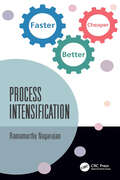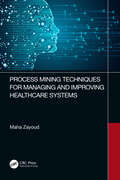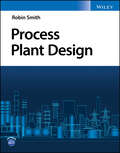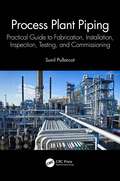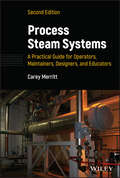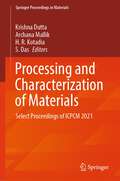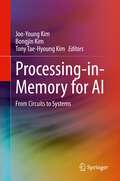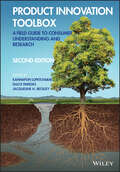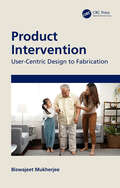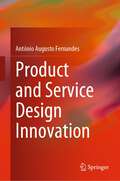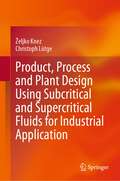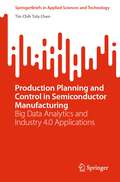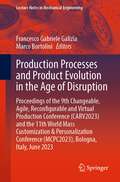- Table View
- List View
Proceedings of the Second International Conference on Innovations in Computing Research (Lecture Notes in Networks and Systems #721)
by Kevin Daimi Abeer Al SadoonThe Second International Conference on Innovations in Computing Research (ICR’23) brings together a diverse group of researchers from all over the world with the intent of fostering collaboration and dissemination of the innovations in computing technologies. The conference is aptly segmented into six tracks: Data Science, Computer and Network Security, Health Informatics and Medical Imaging, Computer Science and Computer Engineering Education, Internet of Things, and Smart Cities/Smart Energy. These tracks aim to promote a birds-of-the-same-feather congregation and maximize participation. The Data Science track covers a wide range of topics including complexity score for missing data, deep learning and fake news, cyberbullying and hate speech, surface area estimation, analysis of gambling data, car accidents predication model, augmenting character designers’ creativity, deep learning for road safety, effect of sleep disturbances on the quality of sleep, deep learning-based path-planning, vehicle data collection and analysis, predicting future stocks prices, and trading robot for foreign exchange. Computer and Network Security track is dedicated to various areas of cybersecurity. Among these are decentralized solution for secure management of IoT access rights, multi-factor authentication as a service (MFAaaS) for federated cloud environments, user attitude toward personal data privacy and data privacy economy, host IP obfuscation and performance analysis, and vehicle OBD-II port countermeasures. The Computer Science and Engineering Education track enfolds various educational areas, such as data management in industry–academia joint research: a perspective of conflicts and coordination in Japan, security culture and security education, training and awareness (SETA), influencing information security management, engaging undergraduate students in developing graphical user interfaces for NSF funded research project, and emotional intelligence of computer science teachers in higher education. On the Internet of Things (IoT) track, the focus is on industrial air quality sensor visual analytics, social spider optimization meta-heuristic for node localization optimization in wireless sensor networks, and privacy aware IoT-based fall detection with infrared sensors and deep learning. The Smart Cities and Smart Energy track spans various areas, which include, among others, research topics on heterogeneous transfer learning in structural health monitoring for high-rise structures and energy routing in energy Internet using the firefly algorithm.
Proceedings of the Seventh International Scientific Conference “Intelligent Information Technologies for Industry”: Volume 1 (Lecture Notes in Networks and Systems #776)
by Sergey Kovalev Igor Kotenko Andrey SukhanovThis book contains the works connected with the key advances in Industrial Artificial Intelligence presented at IITI 2023, the Seventh International Scientific Conference on Intelligent Information Technologies for Industry held on September 25-30, 2023 in St. Petersburg, Russia. The works were written by the experts in the field of applied artificial intelligence including topics such as Machine Learning, Explainable AI, Decision-Making, Fuzzy Logic, Multi-Agent and Bioinspired Systems. The following industrial application domains were touched: railway automation, cyber security, intelligent medical systems, navigation and energetic systems. The editors believe that this book will be helpful for all scientists and engineers interested in the modern state of applied artificial intelligence.
Proceedings of the Seventh International Scientific Conference “Intelligent Information Technologies for Industry”: Volume 2 (Lecture Notes in Networks and Systems #777)
by Sergey Kovalev Igor Kotenko Andrey SukhanovThis book contains the works connected with the key advances in Industrial Artificial Intelligence presented at IITI 2023, the Seventh International Scientific Conference on Intelligent Information Technologies for Industry held on September 25-30, 2023 in St. Petersburg, Russia. The works were written by the experts in the field of applied artificial intelligence including topics such as Machine Learning, Explainable AI, Decision-Making, Fuzzy Logic, Multi-Agent and Bioinspired Systems. The following industrial application domains were touched: railway automation, cyber security, intelligent medical systems, navigation and energetic systems. The editors believe that this book will be helpful for all scientists and engineers interested in the modern state of applied artificial intelligence.
Proceedings of the Sixth International Conference of Transportation Research Group of India: CTRG 2021 Volume 1 (Lecture Notes in Civil Engineering #271)
by Animesh Das Prasanta Kumar Sahu Lelitha Devi Debasis BasuThis book comprises the proceedings of the Sixth International Conference of Transportation Research Group of India (CTRG2021) focusing on emerging opportunities and challenges in the field of transportation of people and freight. The contents of the volume include recent advancements in the pavements and materials study like Fatigue damage, Moisture damage prediction, Quantification of Aging of Polymer, and Effect of short-term aging. It also covers rapidly evolving topics like Road network analysis, Location choice analysis for Transit-Oriented Development (TOD), Transit ridership, etc. This book will be beneficial to researchers, educators, practitioners, and policymakers alike.
Proceedings of the Sixth International Conference of Transportation Research Group of India: CTRG 2021 Volume 2 (Lecture Notes in Civil Engineering #272)
by Shriniwas Arkatkar Ashish Verma Lelitha Devi Gowri AsaithambiThis book comprises the proceedings of the Sixth International Conference of Transportation Research Group of India (CTRG2021) focusing on emerging opportunities and challenges in the field of transportation of people and freight. The contents of the volume include Traffic flow theory, Travel Behaviour, Walking Dynamics of Pedestrians, Urban Traffic characteristics, and uncontrolled intersections. This book will be beneficial to researchers, educators, practitioners, and policymakers alike.
Proceedings of the Sixth International Conference of Transportation Research Group of India: CTRG 2021 Volume 3 (Lecture Notes in Civil Engineering #273)
by Avijit Maji Lelitha Devi Madhu Errampalli Gitakrishnan RamaduraiThis book comprises the proceedings of the Sixth International Conference of Transportation Research Group of India (CTRG2021) focusing on emerging opportunities and challenges in the field of transportation of people and freight. The contents of the volume include characterization of conventional and innovative pavement materials, operational effects of road geometry, user impact of multimodal transport projects, spatial analysis of travel patterns, socio-economic impacts of transport projects, analysis of transportation policy and planning for safety and security, technology enabled models of mobility services, etc. This book will be beneficial to researchers, educators, practitioners and policy makers alike.
Proceedings of the Sixth International Scientific Conference “Intelligent Information Technologies for Industry” (Lecture Notes in Networks and Systems #566)
by Sergey Kovalev Andrey Sukhanov Imran Akperov Sebnem OzdemirThis book contains the works connected with the key advances in Intelligent Information Technologies for Industry presented in the main track of IITI 2022, the Sixth International Scientific Conference on Intelligent Information Technologies for Industry held on October 31 - November 6, 2022, in Istanbul, Turkey. The works were written by the experts in the field of artificial intelligence including topics such as machine learning, decision making intelligent systems, fuzzy logic, bioinspired systems and Bayesian networks. The following industrial application domains were touched: railway automation, intelligent medical systems, flexible socio-technical systems, navigation systems and energetic systems. The editors believe that this book will be helpful for all scientists and engineers interested in the modern state of applied artificial intelligence.
Proceedings of the Third International Conference on Information Management and Machine Intelligence: ICIMMI 2021 (Algorithms for Intelligent Systems)
by Vincenzo Piuri Anil Kumar Marcin Paprzycki Dinesh GoyalThis book features selected papers presented at Third International Conference on International Conference on Information Management and Machine Intelligence (ICIMMI 2021) held at Poornima Institute of Engineering & Technology, Jaipur, Rajasthan, India during 23 – 24 December 2021. It covers a range of topics, including data analytics; AI; machine and deep learning; information management, security, processing techniques and interpretation; applications of artificial intelligence in soft computing and pattern recognition; cloud-based applications for machine learning; application of IoT in power distribution systems; as well as wireless sensor networks and adaptive wireless communication.
Proceedings of the World Conference on Intelligent and 3-D Technologies: Methods, Algorithms and Applications (Smart Innovation, Systems and Technologies #323)
by Kazumi Nakamatsu Roumen Kountchev Wenfeng Wang Roumiana KountchevaThis book features a collection of high-quality, peer-reviewed research papers presented at first ‘World Conference on Intelligent and 3-D Technologies’ (WCI3DT 2022), held in China during May 24–26, 2022. The book provides an opportunity for the researchers and academia as well as practitioners from industry to publish their ideas and recent research development work on all aspects of 3D imaging technologies and artificial intelligence, their applications, and other related areas. The book presents ideas and the works of scientists, engineers, educators, and students from all over the world from institutions and industries.
Proceedings of the XV Ibero-American Congress of Mechanical Engineering: CIBIM 22 / CIBEM 22
by Juan Carlos García Prada Antonio Vizán IdoipeThis open access book shows some of the highlights presented at the XV Ibero-American Congress of Mechanical Engineering. The papers explore the forefront of Mechanical Engineering, containing research into fluid mechanics, energy systems, tribology, materials science, robotics, mechatronics, biomechanics, instrumentation, thermodynamics, and mechanical sustainability.
Proceedings on International Conference on Data Analytics and Computing: ICDAC 2022 (Lecture Notes on Data Engineering and Communications Technologies #175)
by Gaurav Gupta Anupam Yadav Joong Hoon Kim Puneet RanaThis book features selected papers presented at International Conference on Data Analytics and Computing (ICDAC 2022), organized by Department of Mathematics, College of Science and Technology, Wenzhou-Kean University, Wenzhou, China, held during May 28–29, 2022. This book includes state-of-the-art current trends in data science, data analytics optimization, soft computing and related areas. Its primary readers are postgraduate students, researchers and academic professionals.
Process Control for Pumps and Compressors (Advances in Industrial Control)
by Steve S. NiuThis book provides a summary of the essential knowledge and working processes involved with control of rotating equipment including:machine characteristics;overall control strategies;detailed design; andbest practices.Emphasis is placed on the role of pumps and compressors as part of the overall process flow rather than treating them in isolation as this tends to optimize energy efficiency.Readers are made aware of the critical roles of rotating equipment and are given a good understanding of their dynamic behaviors, including surge/choke. The author imparts the practical know-how and skills involved in the design and implementation of capacity and anti-surge control and safe-guarding logic. Furthermore, the book discusses real-time monitoring of solutions based on operational requirements, dynamic models for control of supply and demand, cause-and-effect relationships, the use of online and offline data, and collaboration with other engineering disciplines. The text facilitates support for the day-to-day operation of in-house open-platform compressor control applications, encouraging the growth of analytic skills in troubleshooting and fixing common problems; it also inculcates a basic understanding of the principles of third-party proprietary technologies and supports decision-making between in-house and third-party solutions.Process engineers working in the oil-and-gas, refining, petrochemical, and chemical industries who bear responsibility for designing control solutions involving pumps and compressors will find this book an invaluable source of practical advice. This book also helps engineers working on design and maintenance of rotating equipment to understand the perspectives and requirements of process control.
Process Intensification: Faster, Better, Cheaper
by Ramamurthy NagarajanProcess Intensification: Faster, Better, Cheaper presents basic concepts and applications of process intensification (PI) and links their common effects across processes. It defines two fundamental parameters, PI factor, and Cost Impact (CI) factor, and uses these to analyze various applications where Process Intensification has been carried out.Process Intensification principles have, in the past, been applied to diverse fields, ranging from biodiesel production to offshore processing, and this book unifies these aspects to identify the common factors that drive process enhancements. Each chapter investigates a specific application, discusses the key PI principles, and includes problem sets and examples. The book also provides case studies and realworld examples throughout the chapters.Features: Explores Cost Impact of Process Intensification, and their relative magnitudes, as a universal metric Covers a range of industrial applications, including heat and mass transfer, atomization and comminution, and enhanced oil recovery Discusses the application of Process Intensification for clean coal technology and environmental remediation Includes end-of-chapter problems, examples, and case studies The book is intended for senior undergraduate chemical and mechanical engineering students taking courses in Process Design, Process Optimization, Process Synthesis, and Process Intensification.Instructors will be able to utilize a Solutions Manual and Lecture Slides for their course.The eBook+ version includes the following enhancements: Open-ended essay questions to encourage conceptual thinking and apply new information Pop-up explanations of selected concepts and terms throughout the chapters Interactive definition flashcards that summarize key takeaways at the end of the chapter Quizzes within chapters to help readers refresh their knowledge
Process Mining Techniques for Managing and Improving Healthcare Systems
by Maha ZayoudThis book discusses a new process mining method along with a detailed comparison between different techniques that provide a complete vision of the process of data acquisition, data analysis, and data prediction. Process Mining Techniques for Managing and Improving Healthcare Systems offers a new framework for process learning which is probabilistic and enables the process to be learned in an accumulative manner. The steps of prediction modeling and building the required knowledge are highlighted throughout the book, along with a strong emphasis on the correlation between the healthcare domain and technology including the different aspects, such as: managing records, information, and procedures; early detection of diseases; and the improvement of accuracy in choosing the right treatment procedures. This reference provides a wealth of knowledge for practitioners, researchers, and students at the basic and intermediary levels working within the healthcare system, computer science, electronics and communications, as well as medical providers and also hospital management entities.
Process Plant Design
by Robin SmithProcess Plant Design An introductory practical guide to process plant design for students of chemical engineering and practicing chemical engineers. Process Plant Design provides an introductory practical guide to the subject for undergraduate and postgraduate students of chemical engineering, and practicing chemical engineers. Process Plant Design starts by presenting general background from the early stages of chemical process projects and moves on to deal with the infrastructure required to support the operation of process plants. The reliability, maintainability and availability issues addressed in the text are important for process safety, and the avoidance of high maintenance costs, adverse environmental impact, and unnecessary process breakdowns that might prevent production targets being achieved. A practical approach is presented for the systematic synthesis of process control schemes, which has traditionally received little attention, especially when considering overall process control systems. The development of preliminary piping and instrumentation diagrams (P&IDs) is addressed, which are key documents in process engineering. A guide is presented for the choice of materials of construction, which affects resistance to corrosion, mechanical design and the capital cost of equipment. Whilst the final mechanical design of vessels and equipment is normally carried out by specialist mechanical engineers, it is still necessary for process designers to have an understanding of mechanical design for a variety of reasons. Finally, Process Plant Design considers layout, which has important implications for safety, environmental impact, and capital and operating costs. To aid reader comprehension, Process Plant Design features worked examples throughout the text. Process Plant Design is a valuable resource on the subject for advanced undergraduate and postgraduate students of chemical engineering, as well as practicing chemical engineers working in process design. The text is also useful for industrial disciplines related to chemical engineering working on the design of chemical processes.
Process Plant Piping: Practical Guide to Fabrication, Installation, Inspection, Testing, and Commissioning
by Sunil PullarcotThis book is designed as a complete guide to manufacturing, installation, inspection, testing and commissioning of process plant piping. It provides exhaustive coverage of the entire piping spool fabrication, including receiving material inspection at site, material traceability, installation of spools at site, inspection, testing and pre-commissioning activities. In nutshell, it serves as a complete guide to piping fabrication and erection. In addition, typical formats for use in piping fabrication for effective implementation of QA/QC requirements, inspection and test plans, and typical procedures for all types of testing are included. Features: Provides an overview of development of piping documentation in process plant design with number of illustrations Gives exposure to various codes used in piping and pipelines within its jurisdiction Quick reference guide to various applicable sections of ASME B 31.3 provided Coverage of entire construction contractors' scope of work with regard to plant piping Written with special emphasis on practical aspects of construction and final documentation of plant piping for later modifications/investigations This book is aimed at mechanical, process and plant construction engineers/supervisors, specifically as a guide to all novices in the above disciplines.
Process Steam Systems: A Practical Guide for Operators, Maintainers, Designers, and Educators
by Carey MerrittProcess Steam Systems A comprehensive and accessible handbook for process steam systems The revised second edition of Process Steam Systems: A Practical Guide for Operators, Maintainers, Designers, and Educators delivers a practical guide to ensuring steam systems are properly and efficiently designed, operated, and maintained. The book provides comprehensive information designed to improve process steam system knowledge, reliability, and integration into current manufacturing processes. The most up-to-date version of this volume includes brand-new coverage of current codes, sustainability measures, and updated applications. Heat transfer theory and thermodynamics are tied into practical applications with new practice problems ideal for both professionals seeking to improve their skills and engineers-in training. Readers will also find: Thorough design criteria for process steam systems, complete with detailed illustrations for piping and controls An entirely new chapter on the history of steam systems, including the evolution of the ASME code and boiler accidents Revised coverage of current NFPA, ASME, CSD-1, FM, and building codes, as well as new insurance requirements relevant to practitioners in the industry Expansive design guidance for steam system efficiency upgrades Perfect for operations and maintenance staff at manufacturing, healthcare, and commercial laundries, Process Steam Systems: A Practical Guide for Operators, Maintainers, Designers, and Educators will also earn a place in the libraries of consulting engineers and engineering students with an interest in process manufacturing.
Processing and Characterization of Materials: Select Proceedings of ICPCM 2021 (Springer Proceedings in Materials #26)
by Krishna Dutta S. Das Archana Mallik H. R. KotadiaThis book presents select proceedings of the International Conference on Processing and Characterization of Materials (ICPCM 2021) organized by the Department of Metallurgical and Materials Engineering, National Institute of Technology, Rourkela. Various topics covered in this book include materials processing, materials characterization, mineral concentration, metal extraction and refining, surface engineering, thin films and coatings, materials for nuclear, aviation and defence applications, advanced and smart materials, composites, mechanical behaviour, modelling and simulation, materials for energy applications and corrosion and environmental degradation. This book is of interest to researchers and professionals working in the different areas of material science.
Processing-in-Memory for AI: From Circuits to Systems
by Joo-Young Kim Bongjin Kim Tony Tae-Hyoung KimThis book provides a comprehensive introduction to processing-in-memory (PIM) technology, from its architectures to circuits implementations on multiple memory types and describes how it can be a viable computer architecture in the era of AI and big data. The authors summarize the challenges of AI hardware systems, processing-in-memory (PIM) constraints and approaches to derive system-level requirements for a practical and feasible PIM solution. The presentation focuses on feasible PIM solutions that can be implemented and used in real systems, including architectures, circuits, and implementation cases for each major memory type (SRAM, DRAM, and ReRAM).
Product Innovation Toolbox: A Field Guide to Consumer Understanding and Research
by Dulce Paredes Jacqueline H. Beckley Kannapon LopetcharatPRODUCT INNOVATION TOOLBOX Discover how to implement consumer-centric innovation to help create new product development in this latest edition In recent years, behavioral approaches, social media listening, and other new techniques and technologies—digital techniques, augmented intelligence, machine learning, and advanced biometrics, among others—have been foregrounded in innovation research. A focus on the evolving fields of data science and neuroscience is a driving force for both researchers and the people they study. These digital and mobile technologies have enabled researchers to augment listening, observing and categorizing methods, and to adapt new techniques in attempting to better understand consumers. On the other hand, digitized mobile societies, spurred by faster and cheaper internet access, emphasize an interconnectedness that drastically alters human behaviors and creates borderless influences. Even so, the tenets and approaches to insightful deep learning for consumers and other actors, from discovery through to the launch of successful products, remains an intrinsic part of assessing the market. Product Innovation Toolbox brings together key thought leaders and seasoned consumer researchers from corporate R&D, academia, and marketing research companies to share their experiences, advanced consumer research tools and practical tips for successful and sustainable product innovation. By offering these leading-edge tools and insights, the book ensures consumer-centric innovation by linking strategy and a designed approach. The new edition focuses on the integration and connection of all data—both structured and unstructured???for deep learning and activation, rather than a differentiated qualitative—quantitative approach, reflecting the shifting relationships involved in the latest developments in the field. The second edition of Product Innovation Toolbox also includes: Revised material for more than 70% of the manual, with 11 new and extensively updated chapters New tools sections on digital technologies to create novel ways to stimulate and elicit insights from participants, such as Virtual Reality (VR) and Digital Augmentation Upgraded versions of tools in each updated section, with fresh examples New case studies created using the tools from the previous edition, including cases regarding cross-continental marketplaces and cross-cultural societies An emphasis on tools with global applications Product Innovation Toolbox is an essential resource for product developers, marketers, and technologists.
Product Intervention: User-Centric Design to Fabrication
by Biswajeet MukherjeeThis book covers all aspects of design thinking and its intervention as needed for developing products for the elderly. The book deals with the Universal Principles of Design and how they can be included with Technological Interventions for showcasing the product lifecycle. The main technical features include the Anthropometry calculations, Design Thinking approach on the healthcare products, and selection of target group which is elderly in the presented context. Further, the complete product development cycle, the choice of materials, assessment of the designs, prototyping phases and the final product are all discussed in detail. The various fabrication strategies to reduce the cost of the product, ideation stages and Feedback and Assessment right from design to product development stage are discussed. All the Anthropometry details are included specifically for the target group chosen; its mathematical understanding, error, etc. are all discussed in the book. The ideations, rendering and conceptualization based on Cognitive Ergonomics or Hawthorne and various other effects are also discussed in detail.
Product and Service Design Innovation
by António Augusto FernandesThis textbook describes strategic product and service planning, introducing the concept of innovation. Linear models of product development are presented, and the product concept and system architecture generation are introduced. The responsiveness of the development process to uncertainty and complexity is covered, as well as ways of managing portfolios, programmes and projects. This textbook results from the author's experience of teaching more than 40 years. The methods described in the book have been taught and applied by the students. Examples of concept development projects of products and services carried out by the students are described, many of them revealing great creativity.
Product, Process and Plant Design Using Subcritical and Supercritical Fluids for Industrial Application
by Christoph Lütge Željko KnezThis book describes cutting edge technology using supercritical fluids for the production of foodstuffs, medicals, and polymers. It illustrates the importance and use of basic data for design and operation at industrial scale units. The book's authors have several decades of experience of applied research on how to develop large scale industrial units. It provides readers complete insight in design and operation of industrial high pressure process plants. The book is written so it may be understood for people (with?) little or no background on high pressure process technology. It will provide information on how some foodstuffs, medicals, polymers are produced using high pressure technologies. The book demonstrates the importance of fundamental data, how to measure them and how to apply them to design industrial plants. At the same time, it also serves as a textbook for students.
Production Planning and Control in Semiconductor Manufacturing: Big Data Analytics and Industry 4.0 Applications (SpringerBriefs in Applied Sciences and Technology)
by Tin-Chih Toly ChenThis book systematically analyzes the applicability of big data analytics and Industry 4.0 from the perspective of semiconductor manufacturing management. It reports in real examples and presents case studies as supporting evidence. In recent years, technologies of big data analytics and Industry 4.0 have been frequently applied to the management of semiconductor manufacturing. However, related research results are mostly scattered in various journal issues or conference proceedings, and there is an urgent need for a systematic integration of these results. In addition, many related discussions have placed too much emphasis on the theoretical framework of information systems rather than on the needs of semiconductor manufacturing management. This book addresses these issues.
Production Processes and Product Evolution in the Age of Disruption: Proceedings of the 9th Changeable, Agile, Reconfigurable and Virtual Production Conference (CARV2023) and the 11th World Mass Customization & Personalization Conference (MCPC2023), Bologna, Italy, June 2023 (Lecture Notes in Mechanical Engineering)
by Francesco Gabriele Galizia Marco BortoliniThis book includes state-of-the-art and original research contributions from two well-established conferences, which collectively focus on the joint design, development, and management of products, advanced production systems, and business for sustainable customization and personalization. The book includes wide range of topics within these subjects, ranging from industrial success factors to original contributions within the field. The authors represent worldwide leading research institutions.
